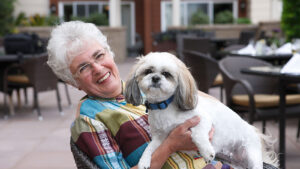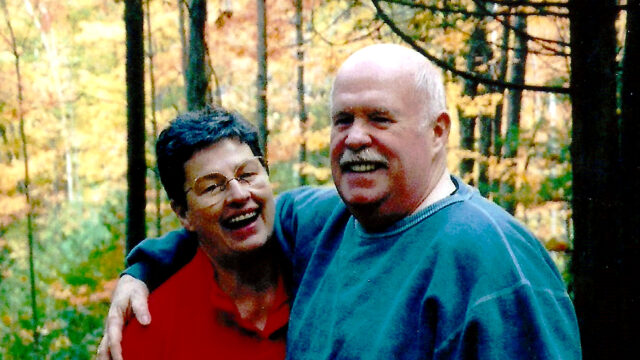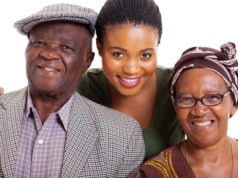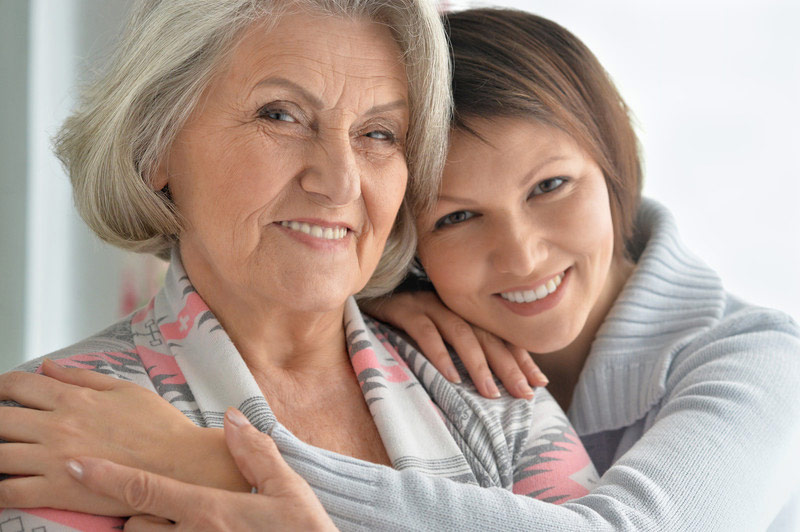Suzanne: And welcome to Answers for Elders Radio Network. And we’re talking today about when your heart is broken over an illness, over a condition, you can’t function anymore, whether it’s movement, whether it’s dementia, whether it’s arthritis, whether it’s… who knows what. But sometimes those things happen, where the things that you used to be able to do, you can’t do anymore. And we are here with Parkinson’s Path expert, Lianna Marie, and Lianna, she and I are gonna be talking about how to channel that disappointment into something positive. So Lianna, welcome to Answers for Elders.
Lianna Marie: Thank you, it’s great to be here.
Suzanne: It’s great to have you here. And I know you have your own story, that you took care of your mom with Parkinson’s years ago, through her life and she dealt with Parkinson’s disease. There’s this decline, right? And so, things happen. Tell me a little bit about that and how did she cope.
Lianna Marie: With the gradual — with the kind of Parkinson’s that my mom had, which was a slow progression and it took ultimately 30 years that she lived with the disease — she would have a pretty productive, as she would call it, life. Most of, half of that anyways, in terms of her ability to move and do things, and when she experienced decline, whether it was physical or mental, cognitive decline, I should say, there were times where she needed some outlets to deal with those disappointments. And one of the things that we talked about earlier, and I’ve talked about a lot, is exercise and how all of us can use that to work through things. But another is creativity, and I wanted to talk about that today, because it is an area that a lot of people with Parkinson’s are starting to become aware of, and using their various creative outlets to help them cope through whatever emotions they may be going through: anxiety, sadness, fears of whatever. And really, just finding that place where they can feel like they’re — I don’t know how to explain it, but I would say that Carrie Fisher quote of, ‘turn your broken heart into art,’ I’ve loved forever, ever since I heard it, was just managing that, that sense of loss and turning it into something.
There’s two cool things that happen in people with Parkinson’s. One is, they’ll start medication and it’s to supplement the dopamine that’s they’re losing. So most likely most people will get on some form of dopamine and, I don’t know when this occurred recently, in the last several years, that doctors started noticing or folks started noticing, ‘hey, I’m getting a lot more creative. Like, I didn’t used to be a painter and now magically, I can paint this beautiful masterpiece.’ And there are some actual studies going on right now saying this extra dopamine is pointing to higher creativity levels, and it’s this phenomenon. We’re not exactly 100% sure what, but this increase in dopamine, when folks are on that, especially in the beginning and middle stages of Parkinson’s, where they start noticing that they can be, like I said, anywhere from like I’ve seen people doing welding projects to creating clocks, to photography, to painting, things that they wouldn’t otherwise have done before. And it’s really quite fascinating. So there’s one, that it can be their medication that’s helping them become that way. But we are also directing people to find that creative outlet to help them just as a way to turn broken heart into art.
Suzanne: And I can relate to it. When I was a caregiver for my mom, and I’d lost my job and I was broken-hearted with everything. What did I do, is I channeled everything, starting a company. That’s me. But that was the thing, it gave me, I could envision something, I could dream about something, I could get passionate about something. And that to me was my thing. But I can see so many ways in which creativity doesn’t necessarily mean “art.” It could be dance.
Lianna Marie: A way in which you express yourself and you can continue to express yourself with your disability, if there is one physical disability — some people experience a physical disability at the very beginning with Parkinson’s, others not. And so, and there’s a really neat website. I was just looking over, it’s Parkinson’s Art https://parkinsons.art/, and folks around the world are contributing to this site, and there are various forms of art, and you can take a look at it because it speaks for itself. You’ll see. And as a person, we have Parkinson’s, you may want to yourself contribute, and it’s a way that you can share your work, whatever you’re doing. Some folks are creating videos, others all different kinds of art. But it’s just another way to showcase it, and within the community of people with Parkinson’s, so it’s a neat little thing.
My mom, her creative outlet, and I call it creative, is gardening. And as she got a little bit more challenged physically, she had someone help her. She had a rock garden on a slope and various flowers, and she had a vision of what she wanted that to look like. And I had a friend who — I told this story a long time ago — but it was not me. I am not the person who does the gardening. It’s not on my resume, but we learned the hard way because my mom would say do this, do this, do this. And I’d be like mom, I’m just gonna do it this way. And she’s like, no, that’s not how the garden works. So we got a friend to help us out, all that to say mom’s creativity was channeled through this other woman who was brilliant at it. So that was one way we adapted, in terms of mom having this wanting to get this creativity out with regards to her flowers, and how they were going to be arranged, and having someone to help her with that. And for others, it’s all different kinds of creativity, like you said. For me, like similarly to you, putting together books, writing, helping other people — that was channeling my disappointment or sadness if you will over my mom.
Suzanne: But you’re also athletic.
Lianna Marie: That was a big channel. I always use my swimming as a channel, for whatever I need. But I don’t see that as creative. But yeah, it has definitely always been there to help me get through challenges.
There’s another thing I was gonna mention. Google Arts and Culture https://artsandculture.google.com/ is really neat. I discovered this during the pandemic, because it’s something that I always think of. I’m trying to think of folks that maybe are less ambulatory. People who can’t get around as easily, to immerse themselves in creative outlets. And Google Arts and Culture is a site where you can go, and many people have probably already heard about this, but you could visit a lot of museums virtually now. And that’s actually thanks to the pandemic because they created virtual ways, so you’re literally walking through the museum. So not every museum offers this, but it’s kind of a neat way to get inspired if you’re unable to visit in person, for example. Because I find being immersed in things like that helps my creativity, gets me inspired. Just, just one little tip, literally just go to Google.
And another thing that it’s kind of similar but different. It’s this concept called Forest Bathing. I don’t know if you’ve ever heard of this? It’s Japanese. And so it’s a concept. and I won’t even try to butcher the name [shinrin-yoku]. But the word relates to, it’s called forest bathing. https://www.nationalgeographic.com/travel/article/forest-bathing-nature-walk-health And all it is, is to try to get you to immerse yourself in all your senses whilst going into a forest. It sounds very basic. But again, it’s to get in tune, it’s somewhat the mindfulness. It’s to get in tune with the sounds, if there are any in the forest, with the feels, with the smells, with everything. And again, it’s to get you centered. And oftentimes people find being connected to nature is also a way that inspires their creativity.
And photography, lots of photography. My mom ended up being inspired by nature, and picked up photography after her Parkinson’s diagnosis, and was really into that. So just an idea, there’s always avenues. I feel like everybody has a creativity within themselves of some kind. The question is how is that gonna come out, and getting involved with groups is also another way. I find that with various support groups, Parkinson groups, can help too, because I think people like that are in the same boat as you are very often encouraging you to be involved, or to let your creativity flourish, and they’re like, that’s really good, you should continue on with that, you know.
Suzanne: When you’re talking about that, support groups can be so powerful, group activities, things like that where you can kind of not feel like you’re the isolated one out where we talked about in an earlier segment. Like maybe you go on a field trip somewhere, or attend a sporting event together, or whatever that is, you have that opportunity to find things that give you joy.
Lianna Marie: That make you feel alive. Make you say, yeah, that’s me! I try to find for everyone. Because once you get that click, you’re like, oh, you forget about everybody else who you thought was staring at you, because you are in tune with you, your own creative self and who you are.
Suzanne: Absolutely. That’s so important and I encourage our listeners today to think about, even if you don’t have Parkinson’s disease, this is a good lesson for all of us If we can take the time and think about, what is our joy? What brings you joy, and find things every day that you have something to look forward to. And I think that’s the thing that is the most valuable things in life, that it’s not all work.
Lianna Marie: Absolutely. So there you go.
Suzanne: ASo, Lianna, I love all the information that you share, and to each and every one of you, she has other podcasts on our platform and you can just search Lianna Marie on Apple, or Google, or Spotify, or anything like that. And we invite you to listen to more of Lianna’s work. And Lianna, thanks so much for being with us today.
Suzanne: Thank you.













